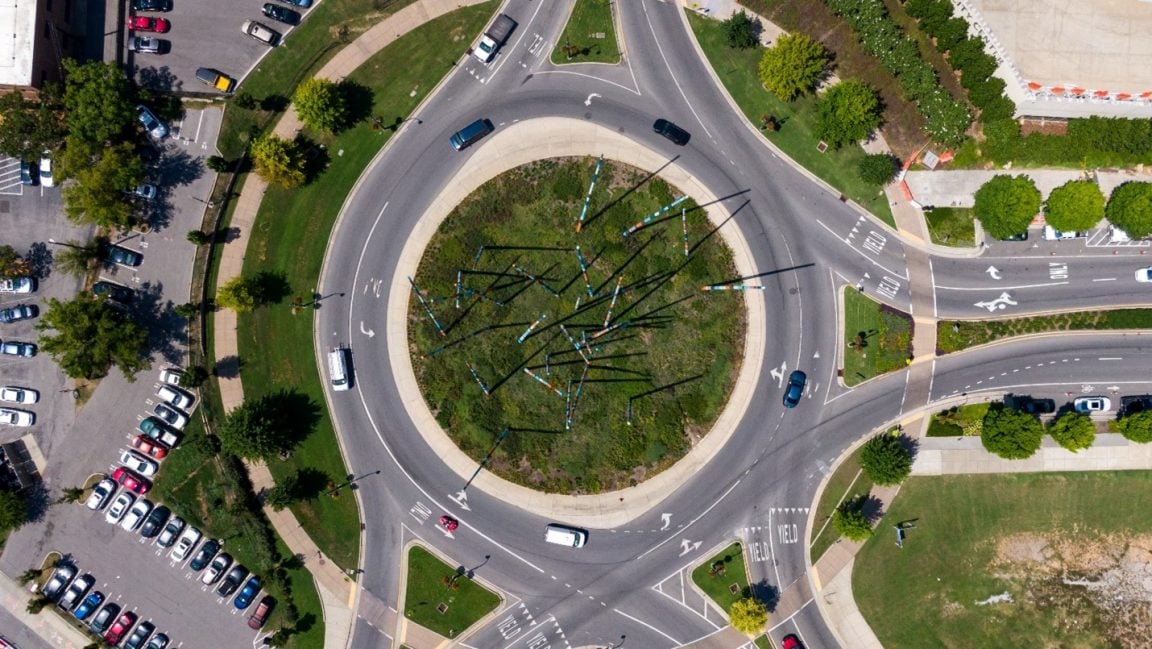A roundabout is a crossroads with a central ring where only one direction of traffic may flow. For drivers, bikers, and pedestrians, they are becoming more and more popular.
Unfortunately, drivers who do not understand how to drive on a roundabout or who do not follow the laws and cause an accident are a problem.
Even though cars go at a reduced pace on a roundabout, you still have the potential of a severe injury in a car accident despite this.
Our legal team is ready to register your claim and seek the money you deserve from the irresponsible driver’s insurance carrier.
What Exactly Is a Roundabout?
Traditional intersections use a traffic signal or stop sign from regulating traffic flow. There is a central island in a roundabout.
As they pass around the roundabout, vehicles depart and continue their journey on the opposite side of the circle. Thanks to the new design, traffic flows in and out of the road without interruption.
There is no need for traffic lights or other traffic monitoring with a roundabout. Drivers approaching the roundabout are expected to yield to those already on the road.
Instead of forcing vehicles to halt at a stop sign when drivers refuse to yield to the person with the right-of-way or obey traffic signals, this results in a 30-50% increase in vehicle capacity over typical junctions.
Causes of Roundabout Accidents
Using roundabouts reduces the risk of head-on and right-angle crashes, which are especially dangerous at high speeds. Drivers can cause an accident if they engage in certain risky behaviors:
Speeding
When approaching and entering a traffic circle, slow down. Roundabouts require cars to give way to other traffic, and speeding drivers may not have enough time to slow down.
Inappropriately Driving in a Lane
When a traffic circle contains more than one lane, vehicles must heed the guidance provided by the roadside signage. When exiting a roundabout, these signs indicate to drivers which lane they should use.
Accidents can happen if these crucial guidelines are not followed.
Stopping In the Middle of the Traffic Circle
In roundabouts, traffic constantly flows around the axis of the circle. To come to a halt once you’ve entered the circle is risky, so only do it if you have no other choice.
Not Allowing Pedestrians and Bikers to Cross the Road
Drivers, pedestrians, and bikers all use the roundabouts simultaneously. To avoid a significant collision, drivers must keep an eye out for them.
Not Giving Way
Once the motorist has entered the roundabout, they must give way to traffic already in motion. Failure to do so will lead to an accident.
Exiting a Circle without Using a Turn Signal or Changing Lanes
When exiting a traffic circle, drivers must stay in their lane unless they need to merge into the other lane. Instead of making a lane shift, the motorist should pick the wrong exit or travel around again if it is safer.
Attempting to Pass Heavy Cars without Giving Them Enough Room
Trucks and other heavy vehicles require additional room to move through roundabouts, so drivers should know this. Attempting to get around them is exceedingly risky.
Failure to provide space for emergency vehicles on the road. When an emergency vehicle cannot promptly make it through the circle, this might lead to accidents.
Roundabouts Have Their Advantages and Drawbacks
They tout roundabouts as a safe alternative to 4-way stops. Because they slow traffic, eliminate the necessity for risky left-hand turns, and reduce the risk of collisions.
In fact, some drivers not acclimated to roundabouts might worsen frequent causes of accidents. Such as speeding and distracted driving.
Theoretically, roundabouts are safer than intersections since only one direction of traffic is present. Due to roundabouts’ novelty and distinctive qualities, drivers are at greater risk of making mistakes.
Pedestrians, cyclists, and motorists congregate more at roundabouts than at a typical intersection because of the roundabout’s compact design.
Vulnerable Road Users (VRUs), defined by the National Safety Council as anybody outside the protective barrier of a vehicle, can result in fatal injuries to walkers or adjacent bicycles when close to three thousand-pound automobiles.
Statistics Involving Roundabout Accidents
People are continuously on the lookout for new things because they’re afraid of the unknown. Motorists are wary of roundabouts because they perceive them as a potential danger.
Roundabouts do not increase the likelihood of an automobile collision. Because of this, several governments are urging city planners to include circular crossings in the design of new roadways.
IIHS has highlighted several research findings that support the advantages of using roundabouts. According to one research, when stop signs or traffic signals are replaced with roundabouts, injury accidents drop by 72-80%.
The overall number of collisions at these identical crossings was reduced by 35-47 percent. According to another research, just 10% of the country’s signal-controlled crossings might be converted to traffic circles or roundabouts, saving 51,000 vehicle collisions per year.
Drivers might avoid 231 fatalities and 34,000 injuries if this approach is implemented.
Pedestrians Need to Be Careful In Traffic Circles
Additionally, pedestrians benefit from the better visibility and slower-moving cars with single-lane roundabouts. The center islands provide a secure location to wait for a break in traffic while crossing.
With roundabouts, the failure of automobiles to yield to walkers at pedestrian crossings can be a concern. Crossing the street at a multi-lane roundabout might be more difficult.
Trapped pedestrians cannot cross the street because another vehicle in the next lane has not yielded to the pedestrian’s request to halt.
Pedestrians who are elderly or visually challenged may have trouble spotting traffic breaks on a roundabout.
Some pedestrians may have difficulty crossing the street if there is no stop sign or traffic light to interrupt the flow of cars.
Wrapping Up
After a car collision, the first thing you should do is make sure that no one is critically hurt in both vehicles.
If your car has been seriously damaged, notify the police, and they’ll send an officer to compile a formal report on the incident. Please book an appointment with us for dependable collision repair.


